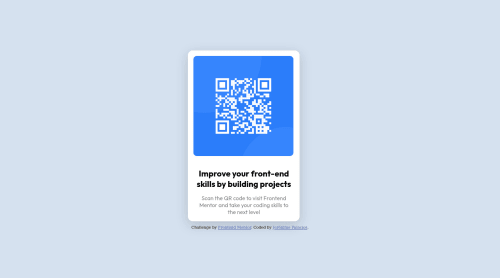QR Component using HTML and CSS

Please log in to post a comment
Log in with GitHubCommunity feedback
- Account deleted
Hey there! 👋 Congrats on completing your first challenge!🎊🍻
Here are some suggestions to help improve your code:
- FEM Best practice ✅, before moving on to the next challenge, always check your FEM report, to see what is incorrect and update your code with it so that you would not make the same mistake over again. This should be the first thing that should be done ⚠️ right after submitting the challenge.
- Avoid skipping heading levels ⚠️. Always start with the
h1(which can only be used once) and you will go down the hierarchy level depending on the heading’s importance.
- ⚠️ All images, illustrations, icons, etc… should always have an
alt tag(regardless if they are decorative or not). For the "QR image" Its needs to tell screen reader users what it is and where it will take them to when they scan it.
- To properly center ✅ your content to your page, you will want to add the following to your
body(this method uses CSS Grid):
body { min-height: 100vh; display: grid; place-content: center; }More Info: 📚
- Change ⚠️
widthtomax-widthin your component’s container to make it responsive. You will also want to remove theheightas it is unnecessary.
- Change ⚠️
widthtomax-width: 100%in your image to make it responsive.
- For improved accessibility 📈 for your content, it is best practice ✅ to use
remfor yourfont-sizeand other property values. Using this unit gives users the ability to scale elements up and down, relative to a set value.
If you have any questions or need further clarification, feel free to reach out to me.
Happy Coding! 🎆🎊🪅
Marked as helpful - @Diggardson270
Congratulations @Jeronimo on completing this challenge It is essential that when including an image on your site, the <img> tag would need to have an alternate text e.g <img src="image path" alt="a short description of the image">.
This feature is helpful to users using assistive technology(screen readers) to be able to know what image is being displayed.
Thank you.
Marked as helpful
Join our Discord community
Join thousands of Frontend Mentor community members taking the challenges, sharing resources, helping each other, and chatting about all things front-end!
Join our Discord